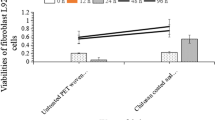Abstract
In this study, isophorone diisocyanate (IPDI), 2,2-bis (hydroxylmethyl)-propionic acid and polyethylene glycol (PEG) were employed to polymerize waterborne polyurethane. The polyurethane prepolymer was extended with chitosan of two different molecular weight (100,000 and 150,000), and used as finishing agent for acrylic fabrics. The antibacterial activity of the acrylic fabric treated with the polyurethane-chitosan solution was improved even after 15 washing times. Pretreatment of acrylic fabrics with hydrazine hydrate was found to improve the uptake of the polymer by the fabric. The effects of hydrazine and polyurethane treatments on some of the inherent properties of acrylic were assessed. The functional groups of polyurethane prepolymer as well as polyurethane extended with chitosan were confirmed with the analysis of the spectra of Fourier transform infrared spectroscopy (FT-IR).






Similar content being viewed by others
References
Lund JS. Defects in the surgical glove barrier. Single or double Gloves. Ugeskrift for Laeger. 2003;165:1016–9.
Gerberding JL, Mc Gowan JE, Tenover FC. Emerging nosocomial infections and antimicrobial resistance. Curr Clin Top Infect Dis. 1999;19:83–98.
Hapburn C. Polyurethane Elastomers. 2nd ed. Oxford: Elsevier; 1991.
Bai CY, Zhang XY, Dai JB, Li WH. A new UV curable waterborne polyurethane: effect of C=C content on the film properties. Prog Org Coat. 2006;55:291–5.
Jiang W-C, Huang Y, Gu G-T, Meng W-D, Qing F-L. A novel waterborne polyurethane containing short fluoroalkyl chains: synthesis, characterization and its application on cotton fabrics surface. Appl Surf Sci. 2006;253:2304–9.
Angeles M, Francisca A, Torro AM, Barcelo CO, Martinezb JM. Characterization of waterborne polyurethane adhesives containing different amounts of ionic groups. Int J Adhes Adhes. 2005;25:507–17.
Park S, Chunga I, Hartwig A, Kim B. Hydrolytic stability and physical properties of waterborne polyurethane based on hydrolytically stable polyol. Colloid Surf A Physicochem Eng Aspect. 2007;305:126–31.
Daniel B, Heidenreich E, Urban MW. Novel waterborne UV-crosslinkable thiol–ene polyurethane dispersions: synthesis and film formation. Polymer. 2005;46:8162–8.
Asif A, Wenfang S, Shenb X, Nie K. Physical and thermal properties of UV curable waterborne polyurethane dispersions incorporating hyperbranched aliphatic polyester of varying generation number. Polymer. 2005;46:11066–78.
Pan H, Chen D. Preparation and characterization of waterborne polyurethane/attapulgite nanocomposites. Eur Polym J. 2007;43:3766–72.
Zhao C, Zhang W. Preparation of waterborne polyurethane nanocomposites: polymerization from functionalized hydroxyapatite. Eur Polym J. 2008;44:1988–95.
Deng X, Liu F, Luo Y, Chen Y, Jia D. Preparation, structure and properties of comb-branched waterborne polyurethane/OMMT nanocomposites. Progr Org Coat. 2007;60:11–6.
Jeong H, Lee M, Kim B. Surface modification of waterborne polyurethane. Colloid Surf A Physicochem Eng Aspect. 2006;290:178–85.
Zhua X, Zhang Q, Liu L, Kong X, Feng S. Synthesis and characterization of a new compound bearing ketone and hydroxyl groups for preparation of ambient temperature self-crosslinking waterborne polyurethanes. Prog Org Coat. 2007;59:324–30.
Jeon H, Jang M, Kima K, Kimb K. Synthesis and characterizations of waterborne polyurethane–silica hybrids using sol–gel process. Colloid Surf A Physicochem Eng Aspect. 2007;302:559–67.
Zhang C, Zhang X, Dai J, Bai C. Synthesis and properties of PDMS modified waterborne polyurethane–acrylic hybrid emulsion by solvent-free method. Prog Org Coat. 2008;63:238–44.
Delpech M, Coutinho F. Waterborne anionic polyurethanes and poly(urethane-urea)s: influence of the chain extender on mechanical and adhesive properties. Polym Test. 2000;19:939–52.
Pedram M, Lagos A, Returet J, Guerrero R, Riquelme P. On the modification of chitosan through grafting. J Pure Appl Chem. 1995;32:1037.
Pedram MY, Returet J. Homogeneous grafting reaction of vinyl pyrrolidone onto chitosan. J Appl Polym Sci. 1997;63:1321–6.
Sugimoto M, Morimoto M, Sashiwa H, Saimoto H, Shigemasa Y. Preparation and characterization of water-soluble chitin and chitosan derivatives. Carbohydr Polym. 1998;36:49–59.
Aiba SI. Studies on chitosan: 6. Relationship between N-acetyl group distribution pattern and chitinase digestibility of partially N-acetylated chitosans. Int J Biol Macromol. 1993;15:241–5.
Shih C, Huang K. Synthesis of a polyurethane chitosan blended polymer and a compound process for shrink-proof and antimicrobial woolen fabrics. J Appl Polym Sci. 2003;88:2356–63.
Gong P, Zhang L, Zhuang L, Lu J. Synthesis and characterization of polyurethane–chitosan interpenetrating polymer networks. J Appl Polym Sci. 1998;68:1321–9.
Lin YH, Chou NK, Wu WJ, Hsu SH, Whu SW, Ho GH, et al. Physical properties of water borne polyurethane blended with chitosan. J Appl Polym Sci. 2007;104:2683–9.
Zhao J, Shanyi D. Grafting of casein onto polyacrylonitrile fiber for surface modification. Fibers Polym. 2006;7(3):235–40.
Judd DB, Wysezcki G. Colour is business science and industry. 3rd ed. New York: Wiley; 1975.
ASTM. Annual book of ASTM standards Part 23. Phildelphia: ASTM; 1982, (Test Method D 2654)
Irob ON, Moo-Young M, Anderson WA. Antimicrobial activity of anntto (Bixa arellana) extract. Int J Pharmacog. 1996;34:87.
Grayer RJ, Harbon JB. A survey of antifungal compounds from higher plants. Phytochemistry. 1994;37:19–43.
Munaza DN, Kim BW, Eluler KL. Antibacterial and antifungal activities of nine medicinal plants from Zaire. J pharmacog. 1994;32:337–45.
Olier P. New aliphatic polyisocyanate for environmentally—friendly PUR coating. Surf coat Int. 2008;6:307–11.
Bendak A, Kantouch A, El-Hossamy M, El-Gabry L. Some characterizations of hydrazine modified acrylic fibres. Bull Natl Res Cent Egypt 1996;21(3):253–64.
Bendak A, Kantouch A, El-Gabry L. Hydrazine treatments on acrylic fibers for new dyeing opportunities. Am Dyestuff Rep. 1995;84(6):34.
Chang KP, Shang CC, Chuan ML. Multi-functional finishing of woolen fabrics. Woolens Tech. 1997;4:61–2.
Author information
Authors and Affiliations
Corresponding author
Rights and permissions
About this article
Cite this article
Atef El-Sayed, A., El Gabry, L.K. & Allam, O.G. Application of prepared waterborne polyurethane extended with chitosan to impart antibacterial properties to acrylic fabrics. J Mater Sci: Mater Med 21, 507–514 (2010). https://doi.org/10.1007/s10856-009-3900-4
Received:
Accepted:
Published:
Issue Date:
DOI: https://doi.org/10.1007/s10856-009-3900-4



